Introduction: Origins of the Bullwhip Effect
- The alignment of chain stages forms the supply change coordination.
- The coordination enhances the total supply chain.
- The lack of coordination results in the bullwhip effect.
- The insufficient coordination may occur due to conflicting objectives.
- The lack of coordination takes place when data are distorted or delayed (Chopra & Meindl, 2013).
- The bullwhip effect provokes inefficiencies in the supply chain (Hofmann, 2015).
The bullwhip effect occurs when there is not enough coordination between various stages of the supply chain (Chopra & Meindl, 2013). The problem is particularly crucial in the modern business because companies have many owners, and each stage has different objectives (Chopra & Meindl, 2013). Another reason why the bullwhip effect occurs is that data are not distributed among all the stakeholders. The bullwhip effect presents a serious challenge to organizations.

The Bullwhip Effect: Causes and Consequences
- Demand fluctuation: a severe issue for operations managers and planners.
- The origin of demand fluctuations is in the supply chain.
- The bullwhip effect is relevant for entire supply chains and single companies.
- The significance of the bullwhip effect is in the variability in supply chain stages.
- The bullwhip effect causes different variability in the upstream and downstream stages (Zotteri, 2013).
Zotteri (2013) remarks that the bullwhip effect of large products can be large due to the specification of incentives. While sales force motivations are aimed at selling towards the end of the month, retailers’ force stimulus is purchasing items with a stable demand (Zotteri, 2013). The bullwhip effect is considered to be self-induced to some extent. One of the major negative outcomes of the effect is the reduction in the service level offered by the company to its retailers in the period of the maximum demand (Zotteri, 2013).
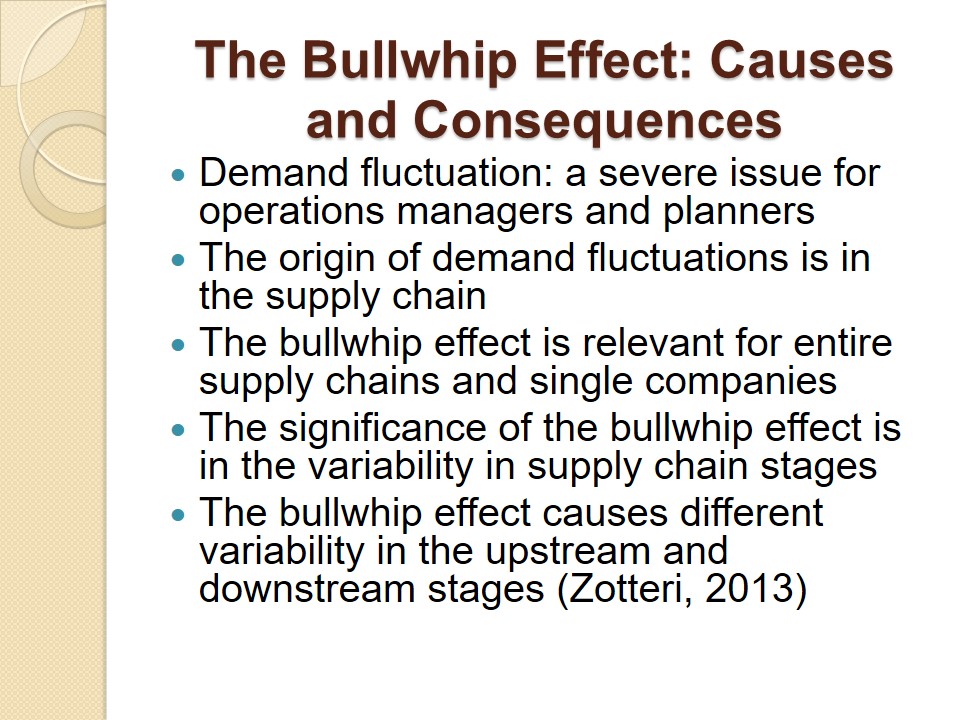
The Negative Impact of the Bullwhip Effect on Performance
The effect influences various aspects of the supply chain, such as:
- Manufacturing cost;
- Inventory cost;
- Replenishment lead time;
- Transportation cost;
- Labor cost for shipping and receiving;
- The level of product availability (Chopra & Meindl, 2013).
Due to the lack of coordination, the variability is increased, and the surplus is damaged. The bullwhip effect leads to the increased manufacturing cost. Because of the effect, a large stream of orders appears, which is a challenge for suppliers. Moreover, the lack of coordination boosts the inventory cost, which leads to the increased need for warehousing space (Chopra & Meindl, 2013). The replenishment lead time is increased in conditions of the bullwhip effect since planning becomes more complicated. Transportation cost is another issue affected by the lack of coordination because requirements vary significantly (Chopra & Meindl, 2013). Finally, because of the bullwhip effect, labor costs are increased, and it is hard to regulate the product availability.

The Reduction of the Bullwhip Effect: Enhancing the Visibility of Data
The bullwhip effect can be reduced by improving data accuracy and visibility that can be achieved through the following measures:
- Sharing the information of customer demand.
- Introducing collaborative planning and forecasting.
- Arranging single-stage replenishment control.
The major cause of information distortion is the use of orders for predicting future demand at each stage of the supply chain (Chopra & Meindl, 2013). Thus, sharing data on customer demand can eliminate the bullwhip effect. Since the ultimate demand to be satisfied is the final customer’s one, it is crucial for retailers to share their data with other stages of the supply chain. The implementation of collaborative planning is useful for reaching the coordination between supply chain stages. It is crucial to make sure that the whole supply chain is working with a unified forecast (Chopra & Meindl, 2013). The single-stage control of replenishment will allow eliminating the distortion of data.
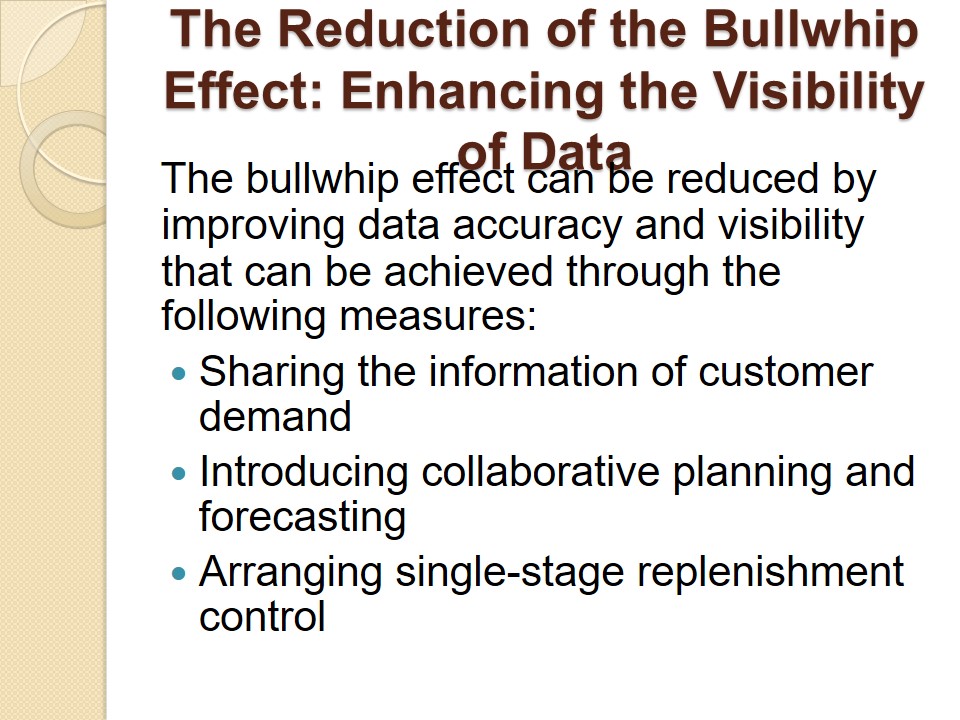
Mitigating the Bullwhip Effect: Using Centralized and Decentralized Internal Model Control Approaches
- A “two-degrees-of-freedom Internal Model Control” (Salcedo, Hernandez, Vilanova, & Cuartas, 2013, p. 261).
- Intuitive and understandable parametrization of controllers.
- Disturbance rejection and inventory target tracking are considered independently from one another.
- If the lead time is known, the approach compensates for the delay.
Salcedo et al. (2013) suggest applying centralized and decentralized Internal Model Control approaches to managing the bullwhip effect. The authors mention that the bullwhip effect can be measured in several ways (Salcedo et al., 2013). The prevalent approach is the ratio of the order rate variance to the demand rate variance. Thus, Salcedo et al. (2013) remark that the scheme proposed by them makes it possible to deal with the difficulties associated with demand rejection and tracking.
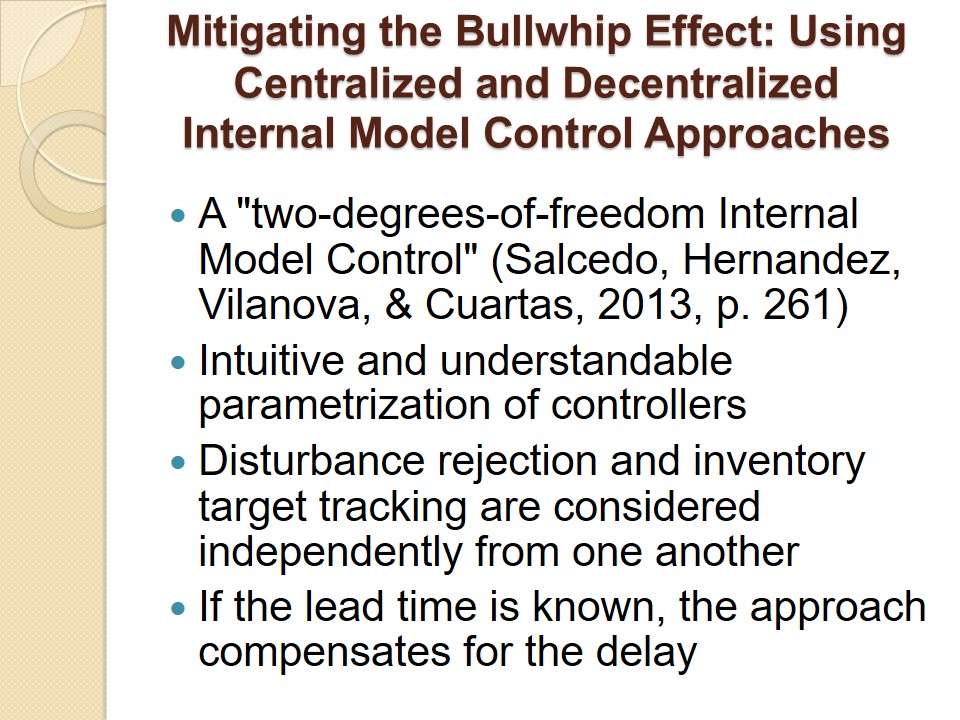
Eliminating the Bullwhip Effect: The Improved Demand Forecasting Approach
- Accurate forecasting is a crucial aspect in enhancing supply chain activities.
- The bullwhip effect is directly associated with demand forecasting.
- The proposed solution: a combination of discrete wavelet transforms (DWT) analysis and the artificial neural network (ANN) ─ DWT-ANN.
In their analysis of the supply chain, Jaipuria and Mahapatra (2014) offer a DWT-ANN model to manage the bullwhip effect. Scholars compare this method to the Autoregressive Integrated Moving Average (ARIMA). Having tested their model with data from three manufacturing companies, Jaipuria and Mahapatra (2014) conclude that the mean square error is comparatively less if applying DWT-ANN in comparison with ARIMA. Thus, the DWT-ANN approach may be considered as an effective one for reducing the bullwhip effect.
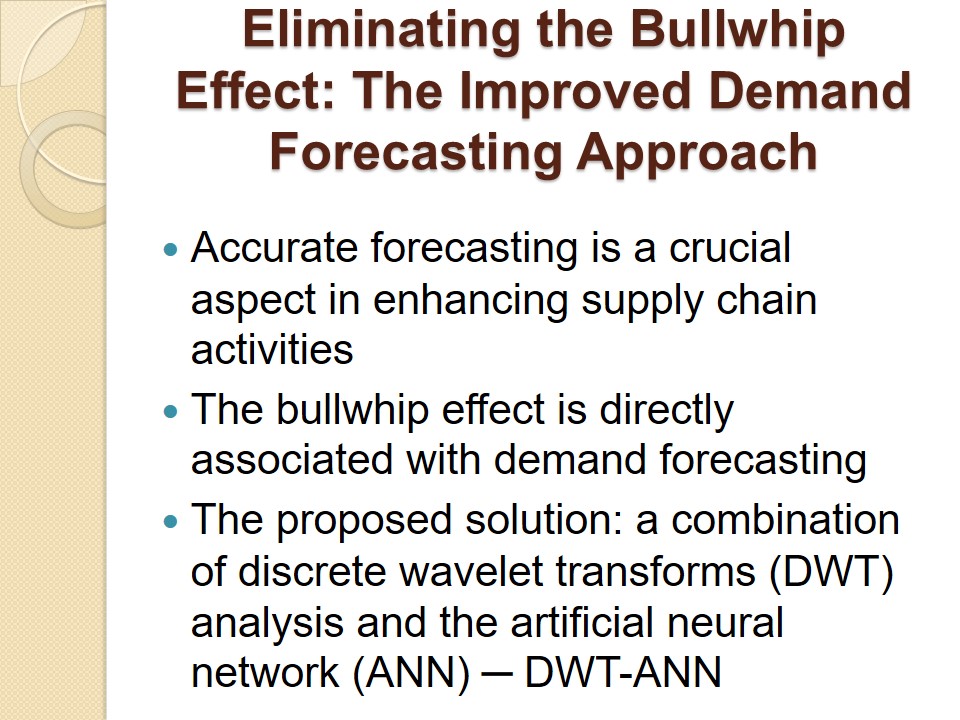
The Bullwhip Effect: Current Data and Opportunities for Future Research
- Available data on the bullwhip effect:
- It can be observed in supply chains;
- It can be decreased or eliminated under certain conditions;
- The effect can be reduced by accurate forecasting;
- Data integration and transparency are also helpful (Wang & Disney, 2016).
- Future research opportunities:
- bullwhip as a general concept;
- nonlinear supply chain models;
- competition;
- intangible services;
- financial and monetary consideration;
- sustainability issues (Wang & Disney, 2016).
Scholars note that although the notion of the bullwhip effect has been investigated considerably over the past twenty years, the understanding of this phenomenon requires more thorough analysis. The questions to focus future research endeavors on include the examination of the bullwhip effect in terms of competition and sustainability. Also, nonlinear supply chain models and intangible services should be analyzed. Finally, as Wang and Disney (2016) remark, it is crucial to study the bullwhip effect as a general concept.
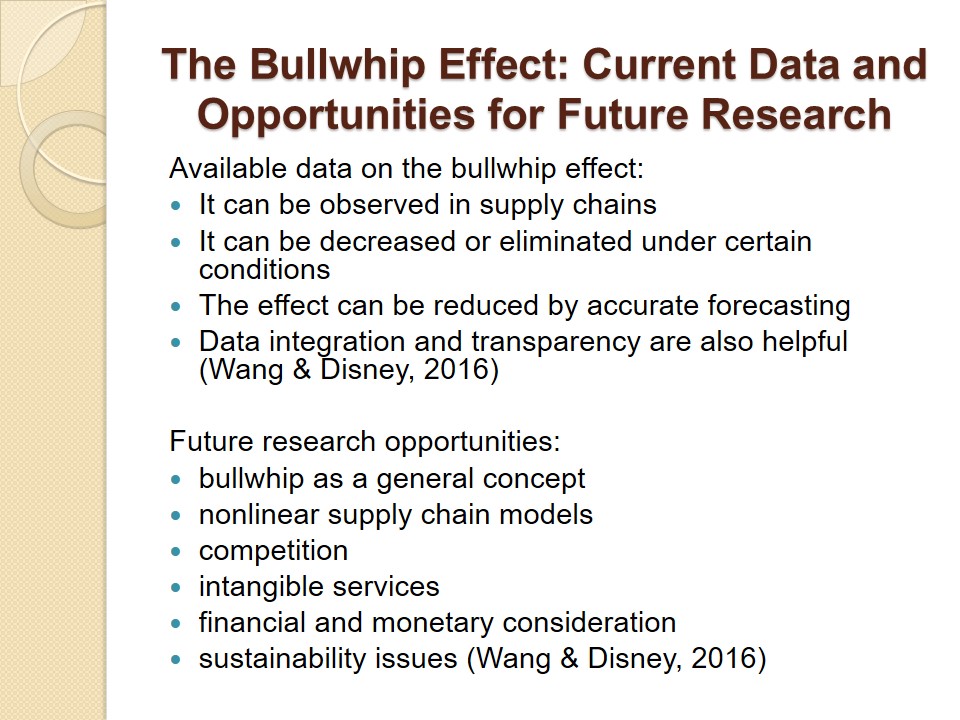
Conclusion
- The bullwhip effect has a negative impact on the supply chain.
- The bullwhip effect causes the lack of coordination.
- There are some effective solutions.
- Future research should focus on new aspects of the issue.
The bullwhip effect has a detrimental impact on supply chain management. Scholars suggest several approaches to mitigate the effect, such as data transparency, Internal Model Control approaches, the improved demand forecasting, and others. At the same time, researchers note that there are some aspects of the problem that need to be investigated more thoroughly in future research.
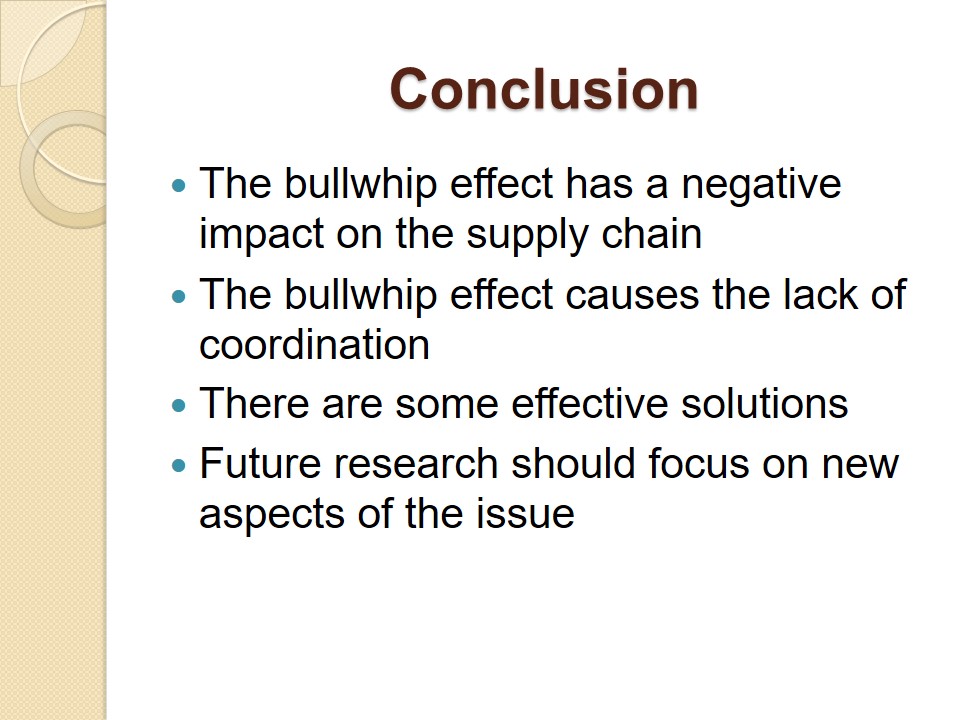
References
Chopra, S., & Meindl, P. (2013). Supply chain management: Strategy, planning, and operation (5th ed.). Upper Saddle River, NJ: Pearson.
Hofmann, E. (2015). Big data and supply chain decisions: The impact of volume, variety and velocity properties on the bullwhip effect. International Journal of Production Research, 55(17), 5108-5126.
Jaipuria, S., & Mahapatra, S. S. (2014). An improved demand forecasting method to reduce bullwhip effect in supply chains. Expert Systems with Applications, 41(5), 2395-2408.
Salcedo, C. A. G., Hernandez, A. I., Vilanova, R., & Cuartas, J. H. (2013). Inventory control of supply chains: Mitigating the bullwhip effect by centralized and decentralized internal model control approaches. European Journal of Operational Research, 224(2), 261-272.
Wang, X., & Disney, S. M. (2016). The bullwhip effect: Progress, trends and directions. European Journal of Operational Research, 250(3), 691-701.
Zotteri, G. (2013). An empirical investigation on causes and effects of the bullwhip-effect: Evidence from the personal care sector. International Journal of Production Economics, 143(2), 489-498.